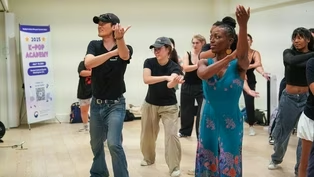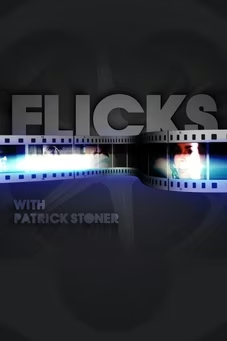
Jabari Jefferson's "Sacred Spaces" Exhibit in Annapolis Combines Black Art, History & Family Stories
Clip: Season 13 Episode 2 | 9m 51sVideo has Closed Captions
A new exhibit by D.C. artist Jabari Jefferson reflects on family, gentrification, and resilience.
WETA Arts host Felicia Curry visits the the Banneker-Douglass-Tubman Museum in Annapolis, Maryland to explore “Sacred Spaces,” a powerful exhibition by D.C. multimedia artist Jabari Jefferson. Through sculpture, mixed media, and installation, Jefferson reflects on family, migration, gentrification, and community resilience.
Problems playing video? | Closed Captioning Feedback
Problems playing video? | Closed Captioning Feedback
WETA Arts is a local public television program presented by WETA

Jabari Jefferson's "Sacred Spaces" Exhibit in Annapolis Combines Black Art, History & Family Stories
Clip: Season 13 Episode 2 | 9m 51sVideo has Closed Captions
WETA Arts host Felicia Curry visits the the Banneker-Douglass-Tubman Museum in Annapolis, Maryland to explore “Sacred Spaces,” a powerful exhibition by D.C. multimedia artist Jabari Jefferson. Through sculpture, mixed media, and installation, Jefferson reflects on family, migration, gentrification, and community resilience.
Problems playing video? | Closed Captioning Feedback
How to Watch WETA Arts
WETA Arts is available to stream on pbs.org and the free PBS App, available on iPhone, Apple TV, Android TV, Android smartphones, Amazon Fire TV, Amazon Fire Tablet, Roku, Samsung Smart TV, and Vizio.
Providing Support for PBS.org
Learn Moreabout PBS online sponsorshipAround the corner from the state courthouse in Annapolis, Maryland, stands the Banneker-Douglass-Tubman Museum, Maryland's official museum of African American history and culture, named after Maryland icons Benjamin Banneker, Frederick Douglass, and Harriet Tubman.
I stopped by to see a special exhibition called "Sacred Spaces" by D.C.
multimedia artist Jabari Jefferson.
I'm so excited to see this piece in particular, because I know it's about your family and your family's history, and I'm noticing immediately the Metro station signs.
Jefferson: Yes.
Yes.
This is my homage to D.C., my D.C.
upbringing as a fifth generation Washingtonian.
I had to celebrate that with this sculpture, which in my opinion is a family tree.
So you see my mother smiling, greeting all the guests.
The Metro stations are how I navigated the city growing up, and then on the back is my father, and on the opposite side of the sculpture is his lineage that came from Virginia.
My mother's side, They all came from the Carolinas.
A recurring motif in the show is human migration and human movement.
Hmm.
It's a really intentional conversation about gentrification in the city, and it was a curatorial choice to have the first room be just a bit of an introduction to who I am as an artist before we get to the main section.
Curry, voice-over: Martina Dodd curates the museum's temporary exhibitions.
You're thinking about the exhibitions that go in the rotating space.
What are you thinking about so that it speaks to what's here in the permanent collection?
The exhibit is called "Sacred Spaces."
Through mixed media, installation, and paintings, Jabari is really thinking about what we think are sacred objects and stories and how are we telling those stories, how are we preserving those histories, and how are we letting other people know that it's important to preserve them.
How does the permanent exhibition speak to the mission of the museum?
The mission of the museum is really to collect, preserve, and interpret material culture about Maryland, but centering African American voices and stories.
So we start off the permanent gallery seeing this installation of us on a ship.
We're starting with this idea that there were bodies of people and communities who were brought over against their will and produced labor and contributed to the commerce of this city and the state, but when you walk into the gallery, you learn even more.
We're not just talking about the labor of African Americans.
We're also thinking about the wisdom and skill and knowledge they possessed.
We're also looking at movements like civil rights movements and education efforts made by African Americans, and then you're getting to see objects, artwork, documents, books that help tell that story.
♪ Curry, voice-over: Dodd led me to the renovated church, where the rest of the exhibition is displayed.
Curry: My eye is immediately turning to this floor-to-ceiling piece right over what would have been the pulpit in the church.
How did a piece like this come to be?
This beautiful tapestry is really honoring the founding commissioners of the Maryland Commission on African American History and Culture, so these individuals came together to preserve this physical building in the 1970s.
Jabari really was inspired by that history and made a altar to the founding commissioners.
Curry, voice-over: I met with the executive director, Chanel Johnson, to learn more.
Can you tell us how this museum came to be?
So in the 1700s, Charity Folks was enslaved in the city of Annapolis.
Johnson: She was later manumitted, and she became a property owner in our state's capital.
Her family would sell the property to a congregation of African Americans just 10 years after emancipation to build Mount Moriah AME church.
The congregation was here for 100 years and in the 1970s sold the property to Anne Arundel County.
Well, the county wanted to tear it down and turn it into a parking lot, but community activists, local historians tapped the newly legislated Maryland Commission on African American History and Culture.
They finally won national preservation status, and in 1984, it opened as the state's first official museum on African American history and culture.
What are the challenges you face as an organization dedicated to the history of Black people?
This is a really challenging time on a federal level when it comes to the consistent attempt to erase and minimize Black history, art, and culture, but our agency was born out of the Civil Rights Movement.
We were born out of the Black Power movement.
We have the archive to prove and to showcase that we've been through this before, we've seen this before, and we will consistently resist, we will consistently preserve and share our history as a tool for community building, as a tool for connection, as a tool for inspiration for others to be positive forces where they live.
That is literally the foundation of Black history in this country.
How did you decide that you wanted to include Jabari's work in your museum?
Oftentimes, we look at artists as the artist and the historian in two separate spheres.
The arts is such a powerful vehicle for sharing, for preserving, and for teaching Black history, so having Jabari here in conversation with our collections, intertwining it with his own family history and love for Black history was incredible, and it really was a transformative project for our team and for Jabari.
Curry: The 18-foot tapestry tribute to the founding commissioners connects to the museum's mission in several ways.
So when you pull your phone up to the tapestry, a video pops up that was created to tell us about the history of the church and then the museum.
On multiple occasions, people were invited to bring in their discarded clothing.
They helped cut and strip these materials and then attach them to canvases that eventually made this tapestry, so I think that builds a legacy of how community members were coming together to save this church and community members came together to build that tapestry.
So here's another.
Curry, voice-over: I got the rest of my tour with the artist himself to get more insight into his perspective.
Was it the space that led you to the title "Sacred Spaces"?
No, it was working closely with the curator Martina Dodd, but the reason I fell in love with that title, not just because this was previously known as a place of worship.
I looked at it as like, man, this is like an alternate reality in which it wasn't turned into a parking lot, and now it gets to host contemporary artwork in it.
I think I'm looking at your picture on there.
Yes, yes, yes.
The piece is featuring Thomas Jefferson, but more importantly, the subject matter of just my family ties.
My family's relationship with enslavement dealt with Monticello, Thomas Jefferson's plantation in Virginia, so I was never really interested in broadcasting that information.
However, I did feel it to be appropriate because the building that we're sitting in was built by freed slaves.
I heard you have a piece here that is-- that speaks specifically to migration.
-Yeah, yeah.
-I'd love to see that.
Yeah, yeah, yeah.
it's called "Exodus."
It's one of one of my favorite romantic pieces.
The piece was inspired by one of my favorite artists, Jacob Lawrence, who did a series of 40 paintings that told the visual story of Black people moving from the South to the North for jobs.
That left such an imprint on me when I was a child that I always longed to be able to make work that was actually talking about important things such as human migration.
Curry: What do you think is the unifying thing that you do in your art that when we look at it we immediately say, "Oh, that's a Jabari Jefferson piece"?
I would say the visual overload aspect of it.
Every single canvas may have between... 50 to 60 different sources that it came from.
The reason I use clothes that were used is I look at it as 50 different articles of different human beings that I would never meet that are now archived in it, so it kind of gives it a life quality.
I think the pieces that are about you, that are about your history, that are very personal, I think that's a hard thing to do as an artist, and I appreciate that you gave us that gift, so thank you for that.
Thank you.
That means a lot to me.
Thank you for acknowledging that, as well.
Curry: The Banneker-Douglass- Tubman Museum is located at 84 Franklin Street in Annapolis and is open Tuesday through Saturday 10 a.m.
to 4 p.m.
Jabari Jefferson exhibition, "Sacred Spaces," is up through December 30th.
Learn K-Pop Dance in Washington, D.C. at the Korean Cultural Center's K-Pop Academy
Video has Closed Captions
Clip: S13 Ep2 | 16m 59s | Go behind the scenes at the Korean Cultural Center's annual K-pop Academy! (16m 59s)
Preview: WETA Arts October 2025
Preview: S13 Ep2 | 30s | K-pop Academy at the Korean Cultural Center; D.C.-based artist Jabari Jefferson. (30s)
Providing Support for PBS.org
Learn Moreabout PBS online sponsorshipSupport for PBS provided by:
WETA Arts is a local public television program presented by WETA

















